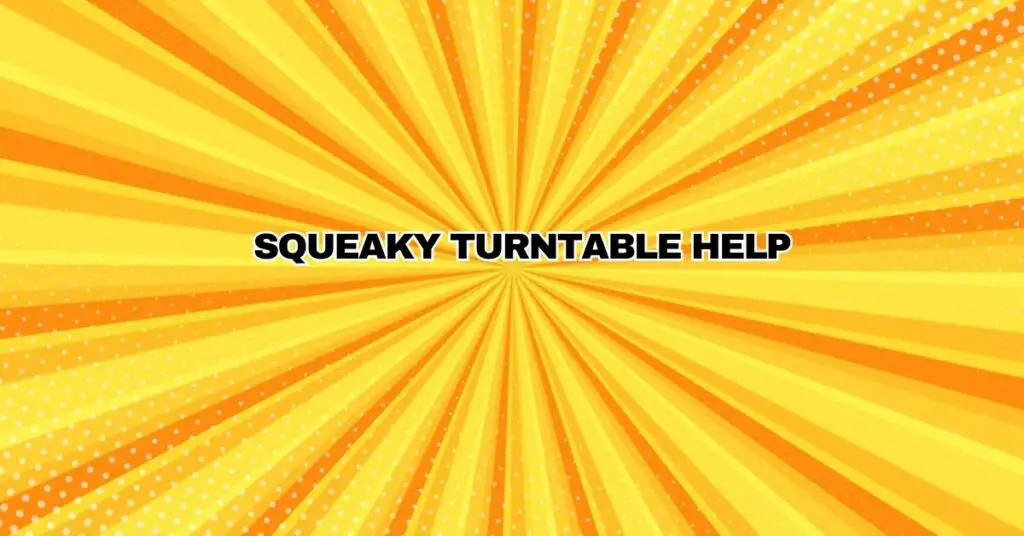Vinyl records, with their rich analog sound and tangible appeal, have been experiencing a renaissance in recent years. The ritual of placing a record on a turntable, lowering the stylus, and immersing yourself in the music is a cherished experience. However, one thing that can detract from this experience is a squeaky turntable. If you’re dealing with this irritating issue, fear not. In this comprehensive guide, we’ll explore the causes of a squeaky turntable, offer practical solutions, and help you restore the tranquility of your vinyl listening sessions.
Understanding the Anatomy of a Turntable
To address the problem of a squeaky turntable, it’s helpful to have a basic understanding of the components involved:
- Plinth: The base of the turntable that houses the motor and other internal components.
- Platter: The rotating platform upon which the record rests during playback.
- Tonearm: The arm that holds the cartridge and stylus, which tracks the grooves on the record.
- Bearing: The mechanism that allows the platter to rotate smoothly and quietly.
- Motor: The component responsible for turning the platter.
Common Causes of a Squeaky Turntable
A squeaky turntable can result from various factors, and it’s crucial to identify the root cause before attempting to resolve the issue. Here are some common causes of turntable squeaks:
- Lack of Lubrication: Over time, the moving parts in a turntable, such as the bearing and motor, may require lubrication. When these parts become dry or dirty, they can create friction and noise.
- Dirt and Dust: Accumulated dirt, dust, or debris on the platter, tonearm, or other components can lead to squeaking sounds.
- Bearing Issues: The bearing, which facilitates the platter’s smooth rotation, can develop problems if it’s dirty, worn out, or damaged.
- Motor Problems: The motor, particularly in older turntables, can develop issues with the bearings or other components, leading to squeaking sounds.
- Misaligned or Loose Parts: If any turntable components are not properly aligned or are loose, they can rub against each other and create noise.
- Belt Issues: In belt-driven turntables, the belt can deteriorate or slip, resulting in squeaky sounds.
How to Silence a Squeaky Turntable
Now that you have a better understanding of the potential causes of a squeaky turntable, let’s explore how to address and resolve this issue:
- Cleaning and Lubrication:
- Start by thoroughly cleaning the turntable. Remove the platter, tonearm, and any removable components to access all areas.
- Use a soft, lint-free cloth to wipe down the platter and other components. You can use a mild cleaning solution if necessary.
- Lubricate the bearing with a turntable bearing oil or synthetic lubricant. Carefully follow the manufacturer’s instructions for application. Be cautious not to over-lubricate, as this can cause other issues.
- Check for Loose Parts:
- Inspect the turntable for any loose parts, screws, or components that may be causing friction. Tighten them carefully but avoid over-tightening.
- Belt Maintenance:
- If your turntable is belt-driven, inspect the belt for signs of wear or damage. Replace it if necessary, ensuring it’s correctly seated on the pulley and the platter.
- Motor Maintenance:
- If the squeak seems to be coming from the motor, you may need to service or replace the motor. This task can be more complex and may require professional assistance.
- Professional Service:
- If you’ve tried the above steps and are still experiencing a squeaky turntable, consider seeking professional turntable servicing. An experienced technician can diagnose and resolve more intricate issues.
Preventing Future Squeaks
To prevent future squeaks and maintain the health of your turntable, here are some general tips:
- Regular Maintenance: Make cleaning and lubricating your turntable a part of your regular maintenance routine.
- Proper Storage: When not in use, keep your turntable covered with a dust cover or stored in a clean, dust-free environment.
- Correct Usage: Handle your records and the turntable with care to avoid accidental damage or undue stress on components.
- Quality Accessories: Invest in high-quality, compatible accessories like turntable mats and anti-static brushes to minimize dust and dirt buildup.
A squeaky turntable need not spoil your vinyl listening pleasure. By identifying the cause and following the appropriate steps for resolution, you can restore the tranquility of your vinyl playback sessions and continue to enjoy the warm analog sound that vinyl records offer.


